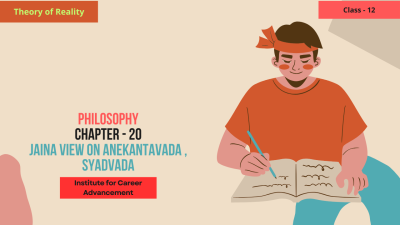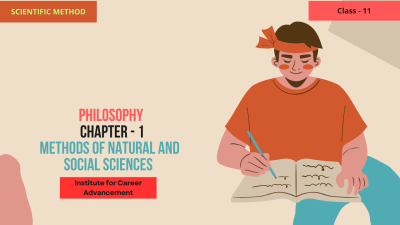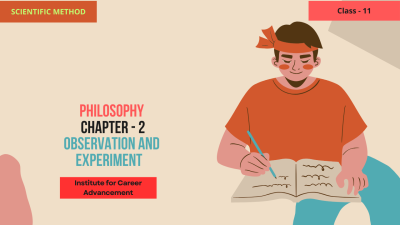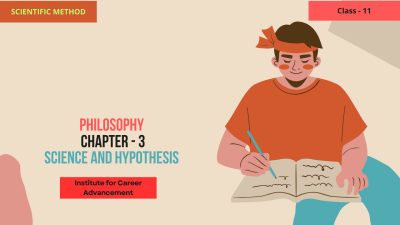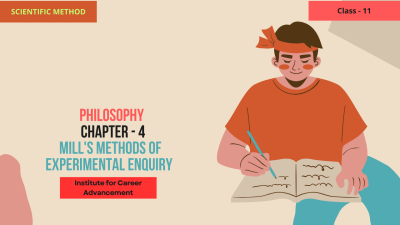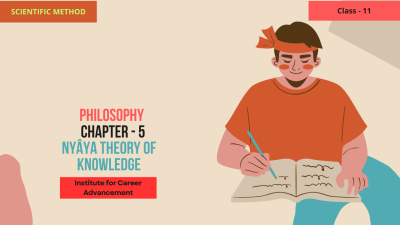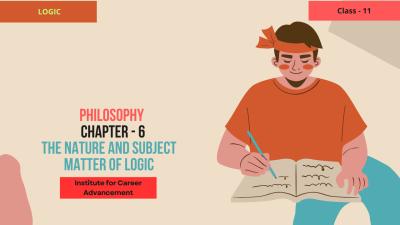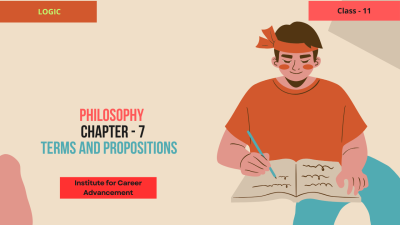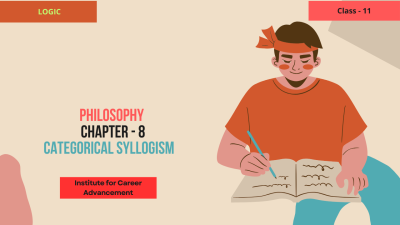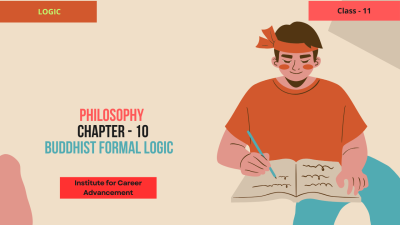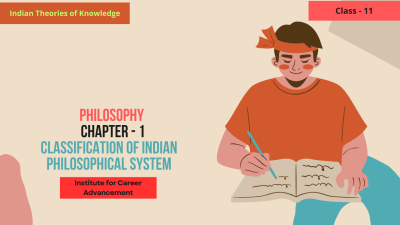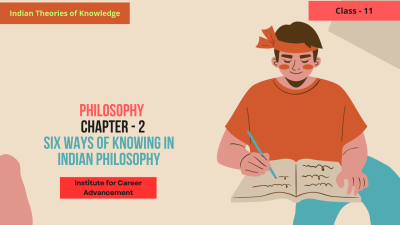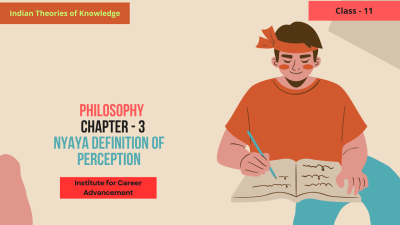Jaina View on Anekantavada , Syadvada - Class 12
In Jainism, Anekantavada and Syadvada are core philosophical principles that emphasize the complexity of truth and the importance of understanding reality from multiple perspectives. 1. Anekantavada (Doctrine of Multiple Perspectives): Anekantavada is the Jain principle of non-absolutism. It asserts that reality is multifaceted, and different perspectives offer valid insights into the same truth. According to this doctrine, no single viewpoint can fully capture the complete truth of any situation, because every truth is seen differently from different angles. The concept suggests that we must recognize and respect diverse opinions and viewpoints. It encourages tolerance and open-mindedness in understanding the world. Example: A mountain might appear differently to someone at the top, someone at the base, and someone from a distance. Each perspective provides partial truth, but none captures the entire reality. 2. Syadvada (Doctrine of Conditional Predication): Syadvada is the logical extension of Anekantavada, often called the Doctrine of Sevenfold Predication. It asserts that statements about truth should be made conditionally, recognizing that different aspects of a situation or object may apply depending on the perspective. In Syadvada, truth is expressed in seven different ways, each depending on specific conditions: Syadasti (It is, from a certain point of view) Syadnasti (It is not, from a certain point of view) Syadasti nasti (It is and it is not, from a certain point of view) Syadavaktavyam (It cannot be expressed, from a certain point of view) Syadasti avaktavyam (It is and cannot be expressed, from a certain point of view) Syadnasti avaktavyam (It is not and cannot be expressed, from a certain point of view) Syadasti nasti avaktavyam (It is and is not, and cannot be expressed, from a certain point of view) This emphasizes that any statement about an object or truth is conditional, reflecting its complexity and multiple facets. Importance in Jainism: Anekantavada and Syadvada teach humility in philosophical discussions, urging individuals to avoid dogmatism and recognize that others' perspectives can hold truth. They promote tolerance, peace, and understanding, as they encourage acknowledging the limits of one’s own perspective and valuing diversity of thought. In Class 12, these concepts help students appreciate the philosophical depth of Jainism and its emphasis on non-violence (ahimsa) and respect for different viewpoints. জৈনধর্মে, অনেকান্তবাদ এবং স্যদ্বদ হল মূল দার্শনিক নীতি যা সত্যের জটিলতা এবং একাধিক দৃষ্টিকোণ থেকে বাস্তবতা বোঝার গুরুত্বের উপর জোর দেয়। 1টি। অনেকান্তবাদ (একাধিক দৃষ্টিভঙ্গির মতবাদ) অনেকান্তবাদ হল অ-দ্রবণীয়তার জৈন নীতি। এটি দাবি করে যে বাস্তবতা বহুমুখী, এবং বিভিন্ন দৃষ্টিভঙ্গি একই সত্যের বৈধ অন্তর্দৃষ্টি প্রদান করে। এই মতবাদ অনুসারে, কোনও একক দৃষ্টিভঙ্গি কোনও পরিস্থিতির সম্পূর্ণ সত্যকে সম্পূর্ণরূপে ধারণ করতে পারে না, কারণ প্রতিটি সত্যকে বিভিন্ন কোণ থেকে ভিন্নভাবে দেখা হয়। ধারণাটি পরামর্শ দেয় যে আমাদের অবশ্যই বিভিন্ন মতামত এবং দৃষ্টিভঙ্গিকে স্বীকৃতি ও সম্মান করতে হবে। এটি বিশ্বকে বোঝার ক্ষেত্রে সহনশীলতা এবং মুক্তমনা মনোভাবকে উৎসাহিত করে। উদাহরণস্বরূপঃ একটি পর্বত শীর্ষে থাকা কারও কাছে, গোড়ায় থাকা কারও কাছে এবং দূর থেকে আসা কারও কাছে ভিন্নভাবে প্রদর্শিত হতে পারে। প্রতিটি দৃষ্টিভঙ্গি আংশিক সত্য সরবরাহ করে, তবে কোনওটিই পুরো বাস্তবতা ধারণ করে না। 2. স্যদ্বদ (শর্তসাপেক্ষ পূর্বাভাসের মতবাদ) সাতবাদ হল অনেকান্তবাদের যৌক্তিক সম্প্রসারণ, যাকে প্রায়শই সাতগুণ অনুমানের মতবাদ বলা হয়। এটি জোর দিয়ে বলে যে সত্য সম্পর্কে বিবৃতিগুলি শর্তসাপেক্ষভাবে দেওয়া উচিত, এটি স্বীকার করে যে কোনও পরিস্থিতি বা বস্তুর বিভিন্ন দিক দৃষ্টিভঙ্গির উপর নির্ভর করে প্রযোজ্য হতে পারে। স্যাদবাদে, সত্য সাতটি ভিন্ন উপায়ে প্রকাশ করা হয়, প্রতিটি নির্দিষ্ট অবস্থার উপর নির্ভর করেঃ স্যদস্তি (এটি একটি নির্দিষ্ট দৃষ্টিকোণ থেকে) স্যাদনস্তি (এটি একটি নির্দিষ্ট দৃষ্টিকোণ থেকে নয়) স্যদস্তি নাস্তি (এটি একটি নির্দিষ্ট দৃষ্টিকোণ থেকে এবং এটি নয়) স্যদাবক্তব্যম (একটি নির্দিষ্ট দৃষ্টিকোণ থেকে এটি প্রকাশ করা যাবে না) স্যদস্তি অবক্তব্যম (এটি একটি নির্দিষ্ট দৃষ্টিকোণ থেকে প্রকাশ করা যায় না) স্যাদনস্তি অবক্তব্যম (এটি একটি নির্দিষ্ট দৃষ্টিকোণ থেকে প্রকাশ করা যায় না এবং করা যায় না) সয়দস্তি নাস্তি অবক্তবিয়াম (এটি একটি নির্দিষ্ট দৃষ্টিকোণ থেকে আছে এবং নেই, এবং প্রকাশ করা যায় না) এটি জোর দেয় যে কোনও বস্তু বা সত্য সম্পর্কে যে কোনও বিবৃতি শর্তাধীন, এর জটিলতা এবং একাধিক দিক প্রতিফলিত করে। জৈনধর্মের গুরুত্বঃ অনেকান্তবাদ এবং স্যদ্বদ দার্শনিক আলোচনায় নম্রতা শিক্ষা দেয়, ব্যক্তিবর্গকে হঠকারিতা এড়াতে এবং অন্যের দৃষ্টিভঙ্গি সত্য ধারণ করতে পারে তা স্বীকার করার আহ্বান জানায়। তারা সহনশীলতা, শান্তি এবং বোধগম্যতাকে উৎসাহিত করে, কারণ তারা নিজের দৃষ্টিভঙ্গির সীমা স্বীকার করতে এবং চিন্তার বৈচিত্র্যকে মূল্য দিতে উৎসাহিত করে। দ্বাদশ শ্রেণিতে, এই ধারণাগুলি শিক্ষার্থীদের জৈন ধর্মের দার্শনিক গভীরতা এবং অহিংসার (অহিংসা) উপর জোর দেওয়া এবং বিভিন্ন দৃষ্টিভঙ্গির প্রতি শ্রদ্ধা উপলব্ধি করতে সহায়তা করে।
English
Last updated
Sat, 11-Jan-2025

